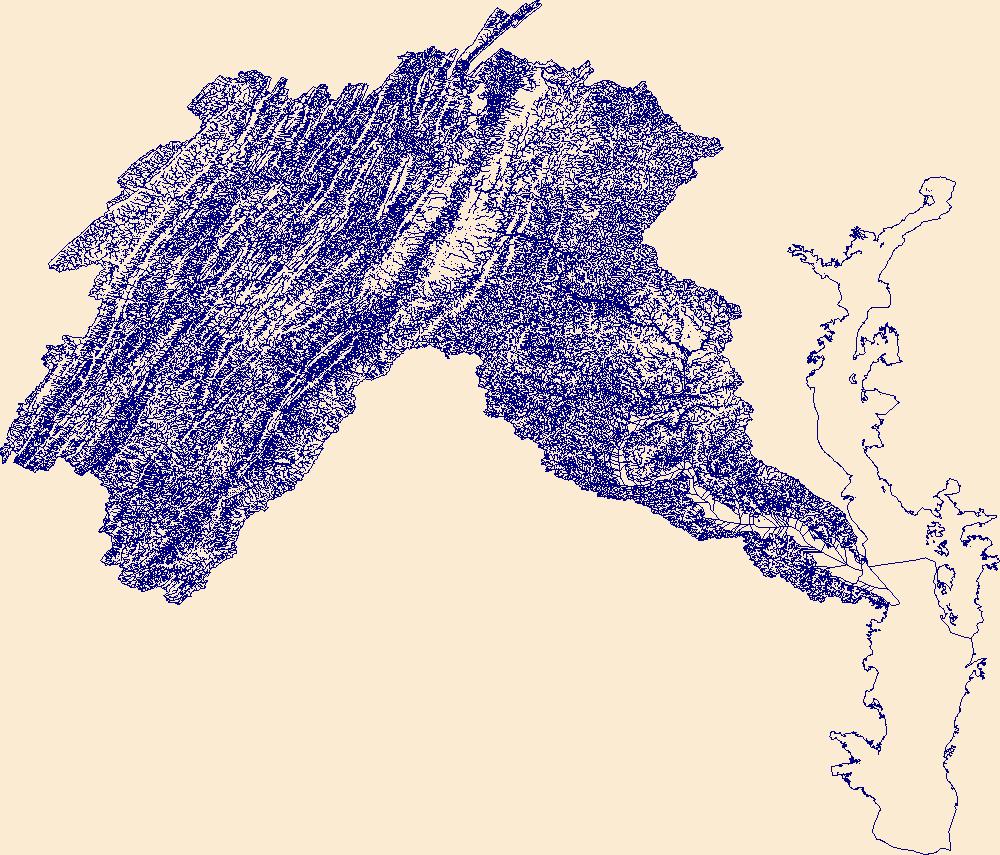Filters: Tags: Hydrology (X) > Date Range: {"choice":"month"} (X)
180 results (19ms)|
Filters
Date Types (for Date Range)
Types
Contacts
Categories Tag Types
|
This data release contains the model inputs, outputs, and source code (written in R) for the boosted regression tree (BRT) and artificial neural network (ANN) models developed for four sites in Upper Klamath Lake which were used to simulate daily maximum pH and daily minimum dissolved oxygen (DO) from May 18th to October 4th in 2005-12 and 2015-19 at four sites, and to evaluate variable effects and their importance. Simulations were not developed for 2013 and 2014 due to a large amount of missing meteorological data. The sites included: 1) Williamson River (WMR), which was located in the northern portion of the lake near the mouth of the Williamson River and had a depth between 0.7 and 2.9 meters; 2) Rattlesnake...
Categories: Data;
Tags: Oregon,
USGS Science Data Catalog (SDC),
Upper Klamath Lake,
Water Quality,
environment,
This product summarizes data used in the analysis portion of our Flood and Storm Tracker (FaST) manuscript (see larger work citation). The dataset titled HUCsppMatrices2012-2022.csv has each Hydraulic Unit Code (HUC) with an introduced taxon in each storm and the HUC it connected to by flood waters (lateral or longitudinal). The dataset titled ConnectionPoints_2012-2022.csv has each lateral (not longitudinal or downstream) connection point for each storm event. The dataset titled LongitudinalConnectionPoints_2012-2022.csv has each longitudinal or downstream connection point for each storm event.
This product includes a model archive using the iRIC-SAC Solver for indirect discharge computation of the spring snowmelt peak flow surveyed on May 27, 2023, and estimated to have occurred in early April 2023. The best-fit discharge for this flood is 3,500 ft3/s. Other data include topographic cross-section data, control points, and high-water marks collected by RTK GPS, and selected photographs of the survey. The location of this survey is a ~300-meter reach of Sand Creek ending at the upstream side of the Shell Creek Stock Trail bridge. Evidence of additional likely coincident floods on tributaries that enter Sand Creek between the Shell Creek Stock Trail bridge and the confluence of Sand Creek with the Little...
The U.S. Geological Survey (USGS), in cooperation with the Air Force Civil Engineer Center (AFCEC), has compiled Geographic Information Systems (GIS) datasets. The spatial data layers provided in this data release are hydrography data derived from high-resolution lidar digital elevation models (DEM). They include a hydroline polyline shapefile used to hydro-enforce the high-resolution lidar DEM; a stream network centerline polyline shapefile derived from the hydro-enforcement that shows stream location; a sub-basin polygon shapefile derived from the hydro-enforcement representing watershed areas for all stream network centerline polylines; a flow direction raster, predicting the direction of flow based on direction...
Three water-quality models were generated to estimate total phosphorus (TP) concentrations and loads from 2002 – 2021 in the Boise River near Parma, Idaho. A Weighted Regression on Time Discharge and Season (WRTDS) model and a Weighted Regression on Time Discharge and Season with Kalman filtering (WRTDS-K) model were generated using all observations within the study period to quantify rate of change in TP concentrations and loads. Further, these two models in addition to the Load ESTimator (LOADEST) model were generated using a subset of the observation data and evaluated on the observations withheld from model generation. The results of the models generated with all data are provided in one file ("full_mod_results.csv"),...
Categories: Data;
Tags: Hydrology,
Idaho,
USGS Science Data Catalog (SDC),
Water Quality,
mathematical modeling,
This dataset includes field hydrologic measurements and laboratory analyses of surface and pore waters, sediments, benthic plants/biofilms, and biota along the Middle Snake River upgradient of the Hells Canyon Complex. The study region for this work focuses on a section of the Snake River heavily utilized for agriculture, with complex systems of irrigation diversion and return drainage, spanning 164 km above the Hells Canyon Complex (Idaho, Oregon). The goal of this study was to identify potential loading sources of methylmercury from the upgradient Snake River into the reservoir complex, with a focus on the tributaries, irrigation return drains, and riparian zones adjacent to agricultural lands along the river....
This project links climate, hydrological, and ecological changes over the next 30 years in a Great Basin watershed. In recent years, climate variability on annual and decadal time scales has been recognized as greater than commonly perceived with increasing impacts on ecosystems and available water resources. Changes in vegetation distribution, composition and productivity resulting from climate change affect plant water use, which in turn can alter stream flow, groundwater and eventually available water resources. To better understand these links, project researchers implemented two computer-based numeric models in the Cleve Creek watershed in the Schell Creek Range, east of Ely, Nevada. The application of the...
Categories: Project;
Types: Map Service,
OGC WFS Layer,
OGC WMS Layer,
OGC WMS Service;
Tags: 2013,
CASC,
Cleve Creek,
Climate,
Completed,

The High Resolution National Hydrography Dataset Plus (NHDPlus HR) is an integrated set of geospatial data layers, including the National Hydrography Dataset (NHD), National Watershed Boundary Dataset (WBD), and 3D Elevation Program Digital Elevation Model (3DEP DEM). The NHDPlus HR combines the NHD, 3DEP DEMs, and WBD to a data suite that includes the NHD stream network with linear referencing functionality, the WBD hydrologic units, elevation-derived catchment areas for each stream segment, "value added attributes" (VAAs), and other features that enhance hydrologic data analysis and routing.

The High Resolution National Hydrography Dataset Plus (NHDPlus HR) is an integrated set of geospatial data layers, including the National Hydrography Dataset (NHD), National Watershed Boundary Dataset (WBD), and 3D Elevation Program Digital Elevation Model (3DEP DEM). The NHDPlus HR combines the NHD, 3DEP DEMs, and WBD to a data suite that includes the NHD stream network with linear referencing functionality, the WBD hydrologic units, elevation-derived catchment areas for each stream segment, "value added attributes" (VAAs), and other features that enhance hydrologic data analysis and routing.
This data release provides a monthly irrigation water use reanalysis for the period 2000-20 for all USGS Watershed Boundary Dataset of Subwatersheds (HUC12) in the conterminous United States (CONUS). Results include reference evapotranspiration (ETo), actual evapotranspiration (ETa), irrigated areas, consumptive use, and effective precipitation for each HUC12. ETo and ETa were estimated using the operational Simplified Surface Energy Balance (SSEBop, Senay and others, 2013; Senay and others, 2020) model executed in the OpenET (Melton and others, 2021) web-based application implemented in Google Earth Engine. Results provided by OpenET/SSEBop were summarized to hydrologic response units (HRUs) in the National Hydrologic...
Categories: Data;
Types: Map Service,
OGC WFS Layer,
OGC WMS Layer,
OGC WMS Service;
Tags: Conterminous United States (CONUS),
Geography,
Hydrology,
USGS Science Data Catalog (SDC),
Water Resources,
In California, the near-shore area where the ocean meets the land is a highly productive yet sensitive region that supports a wealth of wildlife, including several native bird species. These saltmarshes, mudflats, and shallow bays are not only critical for wildlife, but they also provide economic and recreational benefits to local communities. Today, sea-level rise, more frequent and stronger storms, saltwater intrusion, and warming water temperatures are among the threats that are altering these important habitats. To support future planning and conservation of California’s near-shore habitats, researchers examined current weather patterns, elevations, tides, and sediments at these sites to see how they affect...
Categories: Project;
Types: Map Service,
OGC WFS Layer,
OGC WMS Layer,
OGC WMS Service;
Tags: 2012,
Bolinas Lagoon,
CA,
CASC,
California,
This data release contains environmental tracer model inputs, outputs, and model results. Dataset includes environmental tracer concentrations, simulated recharge conditions (water temperature, excess air), and estimated groundwater residence times. This dataset supports an integrated hydrologic investigation of groundwater recharge processes and groundwater flow in the Wet Mountain Valley alluvial aquifer, Custer and Fremont Counties, Colorado. Data were collected by the U.S. Geological Survey in cooperation with the Upper Arkansas Water Conservancy District.
These data were compiled to assess physiological responses of plants to short-term changes in streamflow, both increased and decreased. Objective(s) of our study were to determine the degree to which plants with different habitat preferences and functional strategies responded to short-term increases or decreases in the elevation of the water table. These data represent streamflow rates, temperature, and metrics of plant water status. These data were collected in Glen Canyon National Recreation Area from March 13-27, 2021, and collected by the U.S. Geological Survey-Grand Canyon Monitoring and Research Center. Streamflow data were obtained from the Lees Ferry gage station, and temperature data were obtained from...
The Russian River Watershed (RRW) covers about 1300 square miles (without Santa Rosa Plain) of urban, agricultural, and forested lands in northern Sonoma County and southern Mendocino County, California. Communities in the RRW depend on a combination of Russian River water and groundwater to meet their water-supply demands. Water is used primarily for agricultural irrigation, municipal and private wells supply, and commercial uses - such as for wineries and recreation. Annual rainfall in the RRW is highly variable, making it prone to droughts and flooding from atmospheric river events. In order to better understand surface-water and groundwater issues, the USGS is creating a Coupled Ground-Water and Surface-Water...
Ecological models facilitate evaluation of alternative approaches to restore the Greater Everglades ecosystem. However, the provision of useful and accessible models is a challenge because there is often a disconnect between model output and its use by decision makers. Joint Ecosystem Modeling (JEM) meets this challenge by providing ecological model output tailored to management decisions; ecological models were developed by JEM to evaluate potential effects of restoration projects on natural resources in the impacted areas. The Biscayne Bay and Southeastern Everglades Ecosystem Restoration (BBSEER) Project is part of the Comprehensive Everglades Restoration Plan (CERP). A goal of BBSEER is to identify potential...
This dataset contains data in support of a study by the U.S. Geological Survey (USGS), in cooperation with the U.S. Army Corps of Engineers, to describe water-quality characteristics of the Red River of the North and tributaries prior to construction of the Flood Risk Management Project in the Fargo-Moorhead metropolitan area. This dataset contains bacteria data for ten sites supplied by the North Dakota Department of Environmental Quality, pesticide data for five sites supplied by the North Dakota Department of Agriculture, results from quality control samples collected at ten sites by the USGS as well as files necessary to run loads for ten sites and seven constituents published in U.S. Geological Scientific Investigations...
The data set includes the daily streamflow predictions from (Long Short-Term Memory) LSTM models for 45 basins (27 basins in New England region and 18 basins in Great Basin region) in contrasting hydroclimate regions (water-limited Great Basin region and energy-limited New England region) in the United States. Also, the shapefiles of study basins and hydroclimate regions, and data to support the statistical results, figures, and tables are included.
Categories: Data;
Types: Map Service,
OGC WFS Layer,
OGC WMS Layer,
OGC WMS Service;
Tags: Hydrology,
LSTM,
USGS Science Data Catalog (SDC),
Water Resources,
farming,
These data provide beryllium-7 (7Be) and excess lead-210 (210Pbxs) activity for fine-grained, mobile, streambed sediment in the Black Creek, Indiana (IN) stream-channel network. This basin is monitored in cooperation with the Great Lakes Restoration Initiative (GLRI). During the period July 22-25, 2019 (summer low flow), the thickness and spatial extent of soft, mobile, fine-grained (mainly silt and clay) streambed sediment was inventoried and sampled along 150-meter (m) transects. A combination of stream corridor land-use distribution, valley type, channel slope, stream order (Strahler, 1957), and ecoregion (Omernik and Griffith, 2014) was used to select 30 rapid geomorphic assessment reaches using methods of Fitzpatrick...

The High Resolution National Hydrography Dataset Plus (NHDPlus HR) is an integrated set of geospatial data layers, including the National Hydrography Dataset (NHD), National Watershed Boundary Dataset (WBD), and 3D Elevation Program Digital Elevation Model (3DEP DEM). The NHDPlus HR combines the NHD, 3DEP DEMs, and WBD to a data suite that includes the NHD stream network with linear referencing functionality, the WBD hydrologic units, elevation-derived catchment areas for each stream segment, "value added attributes" (VAAs), and other features that enhance hydrologic data analysis and routing.
This data release contains monthly 270-meter resolution Basin Characterization Model (BCMv8) climate and hydrologic variables for Localized Constructed Analog (LOCA; Pierce et al., 2014)-downscaled HadGEM2-CC Global Climate Model (GCM) for Representative Concentration Pathway (RCP) 4.5 (medium-low emissions) and 8.5 (high emissions) for hydrologic California. The LOCA climate scenarios span water years 1950 to 2099 with greenhouse-gas forcings beginning in 2006. The LOCA downscaling method has been shown to produce better estimates of extreme events and reduces the common downscaling problem of too many low-precipitation days (Pierce et al., 2014). Ten GCMs were selected from the full ensemble of models from the...
|

|